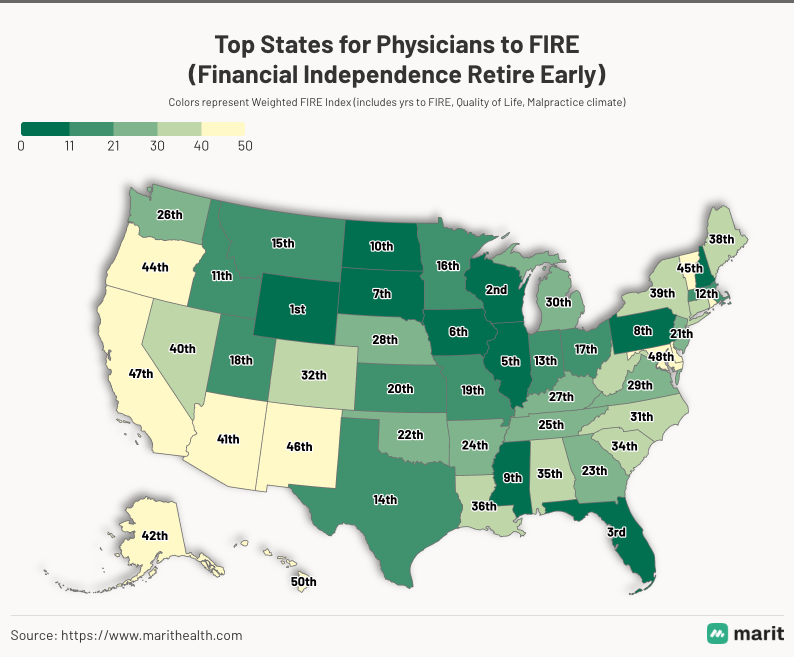This ranking was originally published on Physician on FIRE in collaboration with Marit.
Few things are more appealing to physicians than true financial independence. After all the years of training, student loans, and endless call shifts, the chance to step off the hamster wheel and reclaim time for what matters most feels like the ultimate reward. The income potential is there - but if financial freedom is your goal, you have to think strategically, starting with where you choose to practice.
At Marit, we analyzed thousands of real, anonymized physician salaries from across the country and combined them with data on state taxes, cost of living, quality of life, and malpractice climate to see which states create the fastest path to financial independence for doctors. Our findings show that geography plays a bigger role than many expect. In some states, physicians can reach financial independence in under a decade. In others, it might take two or three times as long, even with similar earnings.
Why Location Matters More Than You Think
A physician’s salary is only part of the equation. The purchasing power of that income depends on what it costs to live, raise a family, and practice medicine in a given state.
For example, a family medicine physician earning $390K in Wisconsin may have a significantly higher savings rate than one earning $430K in California. Once taxes, housing, childcare, and insurance costs are considered, the Wisconsin physician could save twice as much each year – cutting years off the path to FIRE (Financial Independence, Retire Early).
To build a complete view, the Marit team created a Physician FIRE Index based on five key inputs:
- Average Physician Salary: Real-time, peer-reported compensation data from Marit’s salary database
- State and Federal Taxes: Combined effective rates from the Tax Foundation and state tax agencies
- Cost of Living: Data from the Council for Community and Economic Research and the Economic Policy Institute’s Family Budget Calculator, adjusted for typical physician spending patterns
- Quality of Life: Rankings from WalletHub’s 2025 “Best States to Live In,” which include education, healthcare, safety, and community metrics
- Malpractice Environment: Gallagher’s 2025 survey of average premiums and state-level physician-friendliness
By combining these variables, we estimated how long it would take physicians in each state to reach financial independence based on the 25x rule, which assumes you’ve achieved FIRE once your invested savings equal 25 times your annual living expenses. This calculation reflects the point at which investment income can sustainably cover ongoing costs without relying on active work.
The result is a data-driven ranking that blends earning potential with the true cost of achieving financial freedom:


It’s About More Than Money
Financial independence is more than just hitting a number - it means freedom to choose your schedule, your practice style, and when to slow down. Many physicians who reach their retirement goals do not necessarily leave practice altogether. Instead, they might shift to part-time work, teaching, or locums that better align with their values.
The states that best support early retirement tend to offer both financial and lifestyle advantages. Lower housing costs and shorter commutes allow more time for family. Smaller communities offer deeper connections and lower stress. And stable malpractice climates create room for sustainable careers instead of constant pressure to produce more. The right environment allows physicians to build wealth without sacrificing well-being.
Take Control of Your Career and Financial Future
Whether you are finishing training, changing jobs, or planning your long-term future, understanding how your location affects savings potential can reshape your financial strategy.
- Compare after-tax income, not just base salary. Look at your effective tax rate to understand what truly reaches your bank account.
- Factor in housing and childcare costs. Even a modest difference in living expenses can shift your retirement timeline by several years.
- Evaluate the practice environment. A lower-stress setting can make it easier to sustain your income and reduce the risk of burnout.
- Plan for flexibility. A move to a lower-cost state does not have to be permanent, but it can accelerate your progress toward independence.
Marit’s real-time salary data gives physicians a unique advantage in making these comparisons. By pairing compensation data with context on location, practice setting, employer type, schedule, retirement benefits, and more, you can see exactly how your earnings stack up against peers.
Conclusion
When you look at the full picture, one thing becomes clear: where you practice medicine can change your financial future more than almost any other factor. And while the takeaway is not that every physician should move to Wyoming, understanding the tradeoffs of where you work will help you make more intentional career and lifestyle decisions.
In Part 2, we’ll take a closer look at the Top 10 and Bottom 10 states to understand what sets them apart. From Wyoming and Wisconsin to California and Hawaii, we’ll break down how each state’s unique mix of income, expenses, and quality of life shapes a physician’s ability to reach financial independence.


